Google has a plethora of free tools to help with your SEO. But Google Trends is perhaps the most underrated and underutilized SEO tool in Google’s repertoire.
Even if you’re subscribed to premium SEO tools like Semrush or Ahrefs, you can still get a ton of insights and value from Google Trends.
This post explains all the different ways you can use Google Trends to bolster your keyword research and SEO efforts.
By the time you’re done, you’ll have learned exactly how to use Google Trends to arrive at the data and insights you need.
Let’s get started.
What is Google Trends?
Google Trends is a free tool by Google that provides data and insights on the searches that take place on Google and YouTube.
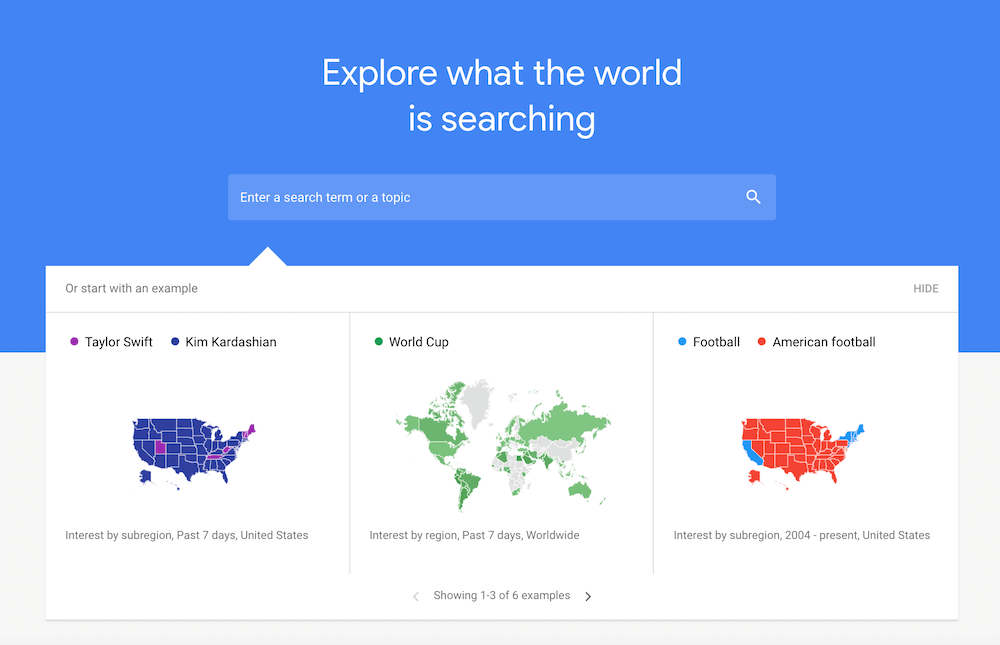
Primarily, the tool shows daily search trends and real-time search trends on Google from around the world.
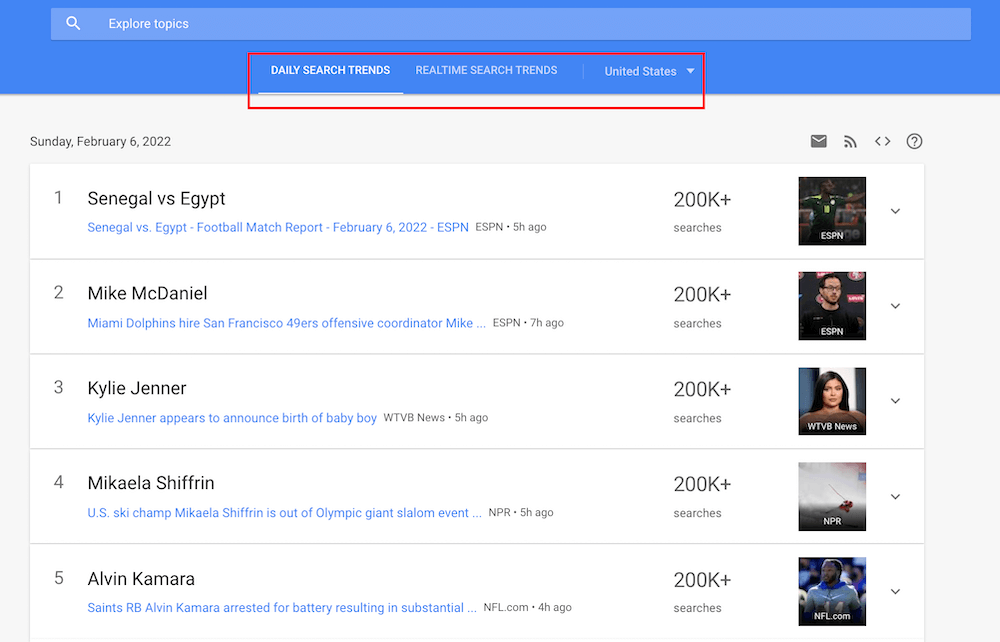
It also displays the level of interest in a particular topic from around the globe or down to city-level geography. For example, here’s the worldwide Google Trends graph for the search query “NFTs” over the past 12 months:
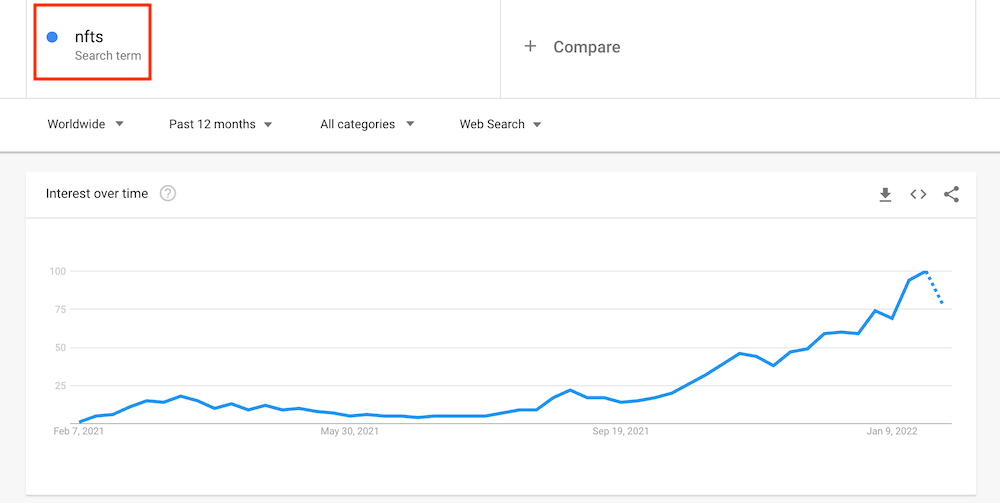
Originally released in 2006, Google has constantly added new features to Google Trends with each new iteration and its latest version was released in May 2018.
In the next section, we’ll explore 9 actionable ways you can use Google Trends to optimize your SEO strategy.
9 Ways to Use Google Trends for Keyword Research and SEO
1. Find New Keyword Ideas
Google Trends’ most talked about feature is “Trending Searches.”
This feature shows you real-time data for searches that have been trending in the last 24 hours.
“Trending Searches” is updated on a daily basis and you can see the 10 most recent things that are trending by checking out the “Recently trending” section.
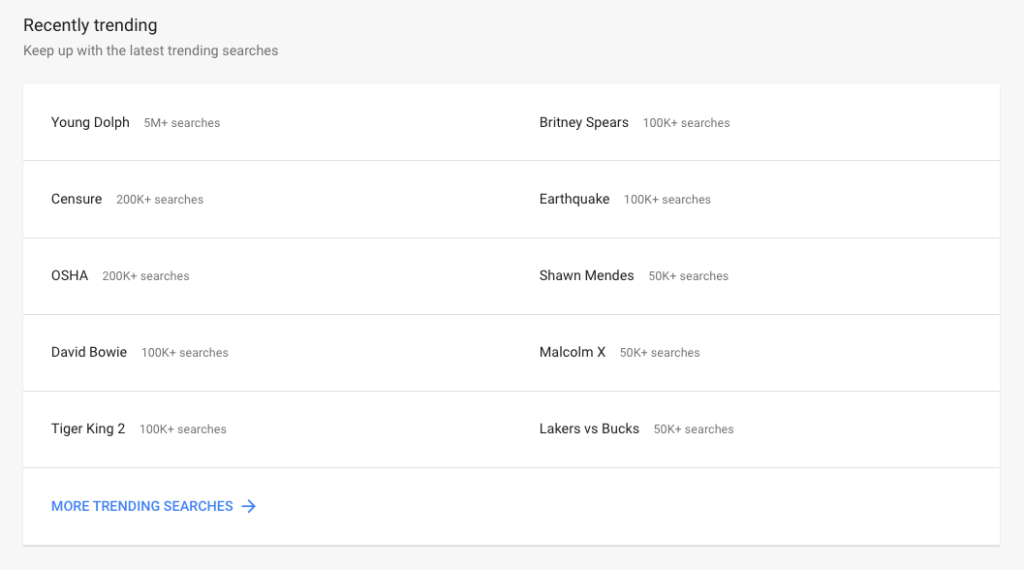
But that’s just a cursory glance of Google Trends. To unpack useful and relevant data, you’ll need to dig a little deeper.
So to dive deeper, hit the “More Trending Searches” button below the section.
This will show you more trending searches.
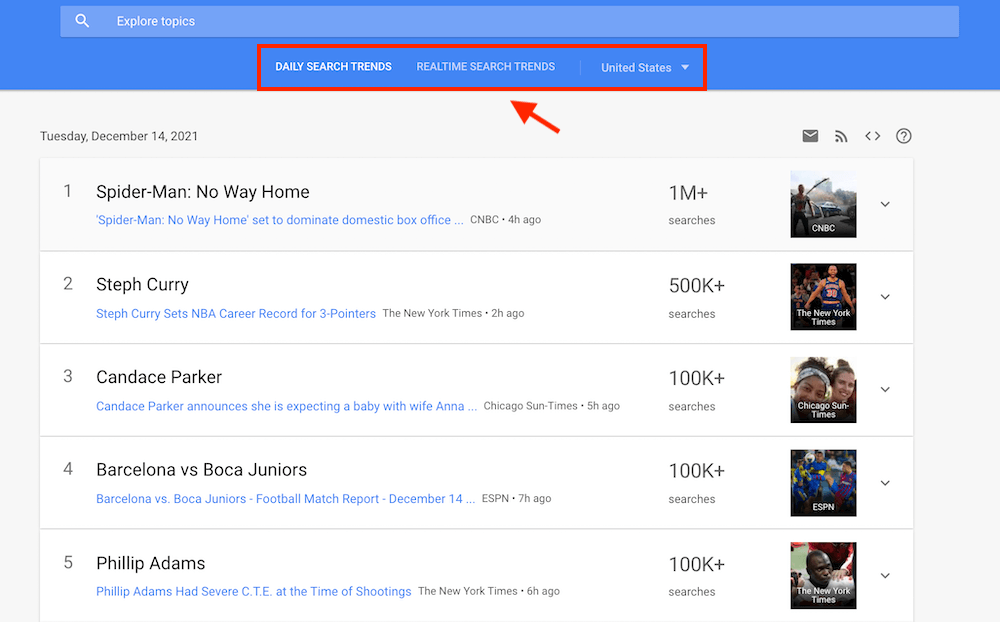
You can then switch between “Daily Search Trends” and “Real Time Search Trends” to see what’s trending in the last 24 hours.
You can even filter the results by country to see what’s trending in your country.
Furthermore, you can select different categories from the category drop-down menu and view all the searches that are trending in that particular category.
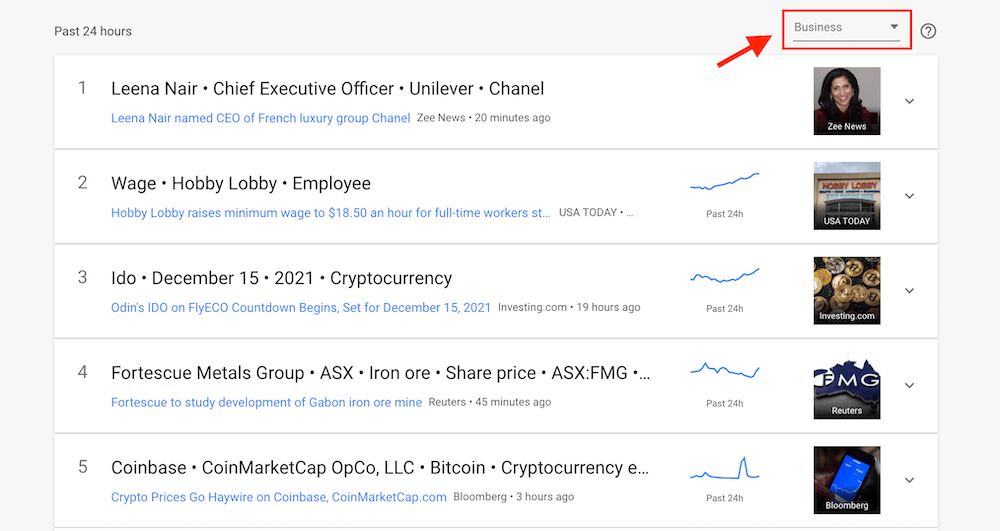
As useful as the tool is to identify real-time search trends, you need to pick your topics wisely.
Why?
Because the topics that are trending now may not be such hot topics in the coming weeks. And sadly, a vast majority of the topics featured here will just be fads and will not resonate with your audience beyond a certain point.
And when you pick these short-term fads as your main keywords, you can only expect a short burst of search engine traffic. Unless you run a news-focused site, you wouldn’t want to pick topics that are short-term fads.
So if you want to create evergreen content that you can revisit and update on a regular basis, you need to use your own judgment to pick future-proof topics.
For instance, here are 3 potential topics I found in the “Business” category that don’t appear to be short-term fads:
- Cloud computing
- Metaverse
- Out-of-home advertising
So make sure to use the category drop-down menu to have better chances of stumbling upon keywords that are not just reserved for news stories.
2. Discover “Breakout” Keywords
Sometimes when you use Google Trends, you’ll notice the term “breakout” instead of percentage growth against the queries in the “Related searches” or “Related queries” column.
Like this:
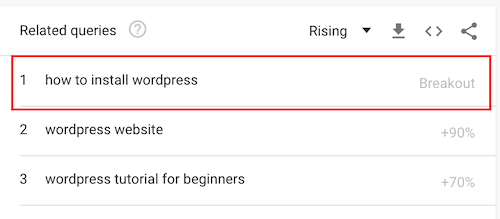
What exactly are “breakout” keywords?
According to Google:
If you see “Breakout” instead of a percentage, it means that the search term grew by more than 5000%.
Put differently, these are search terms that had exponential growth in volume in the requested time frame.
So why should you care about “breakout” keywords?
Because some of these keywords are the least competitive.
Plug these keywords into Semrush and you’ll find their keyword difficulty score to be extremely low.
For instance, a “breakout” search phrase like “content creation hacks” has a keyword difficulty score of just 19 on Semrush.
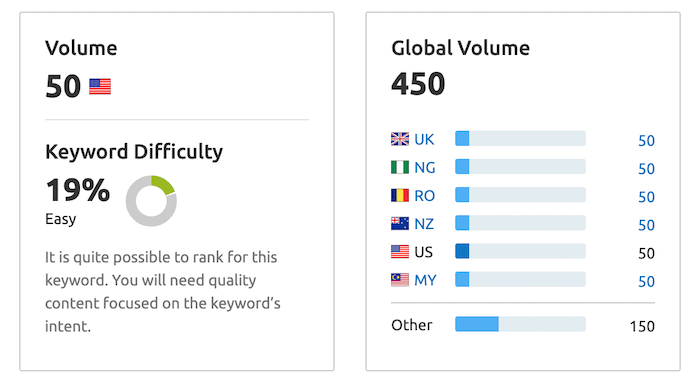
Which means you’ll have a better chance of ranking on top of SERPs for these keywords. And you can do so without actively looking for backlinks. In other words, you’ll have the first mover advantage on keywords that already have a decent search volume on Google.
But there’s a flip side to this approach because some of the “breakout” keywords are just fads.
For example, you can’t expect to generate long-term traffic for a keyword phrase like “oscar nominations 2022.”
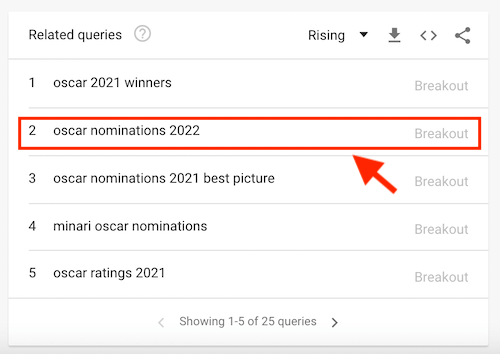
You’ll probably get decent traffic a few weeks leading up to the Oscars, but once it’s over, the traffic will dry up.
Which is why you need to use good judgment while picking out such keywords.
With that in mind, “breakout” keywords shouldn’t be the primary keywords in your content strategy.
That said, if you work for a news-focused website, then this data is worth gold.
3. Optimize Your Local SEO
Since the results and reports in Google Trends can be filtered by locations, you can use the tool to improve your local SEO.
You can filter the results not just by states and cities within a country, but also by subregions.
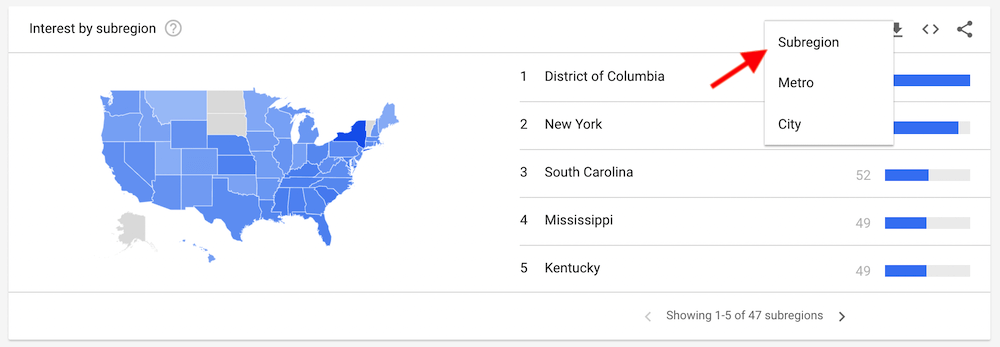
You can use this feature to discover local trends and create content that is specifically tailored to that audience.
You can also use Google Trends to determine the interest level for your product or service in your city.
For instance, let’s say you want to open a coworking space in Austin, Texas.
How do you know if people in Austin are interested in working from a coworking space?
Google Trends has you covered.
Simply search for “coworking” in Google Trends and then scroll down to the “Interest by subregion” section. Change the filter to “Metro” and you’ll get a breakdown of the top metros that are searching for this term on Google.
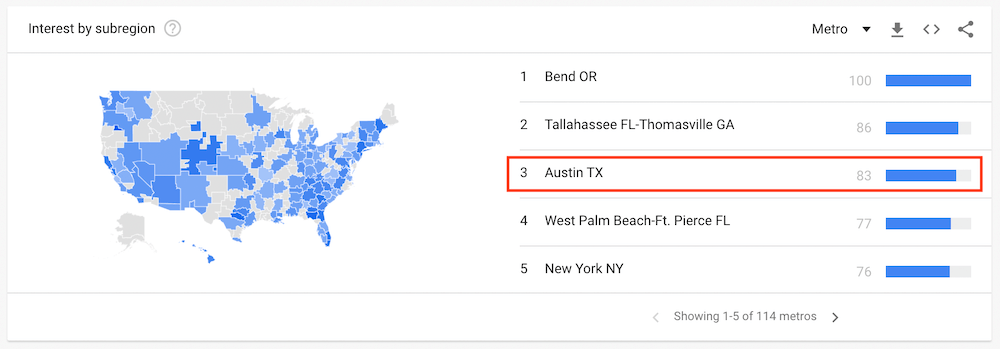
As you can see from the screenshot above, the search interest for “coworking” is pretty high in Austin.
In addition, you can search for keywords that are closely related to “coworking” on Google Trends and check out the search interest for such keywords in your city.
You can then use these keywords to optimize your landing page that’s specifically tailored towards entrepreneurs, small business owners, and freelancers in your city.
Related: 10 Best Local SEO Tools to Improve Your Local Search Rankings
4. Get Accurate Search Volume Trends
Search volume is the total number of searches performed over a period of time for a specific keyword phrase. It’s one of the most important SEO metrics.
With Google Trends, you can type in any keyword and see the search volume trends for your target keywords over a selected time frame.
Why is this important?
Because you get a clear picture of how popular your target keywords are and you’ll be able to create content around keywords that are rising in popularity.
And since it’s Google’s own data, you can trust its accuracy.
To get started, enter a keyword phrase into the Google Trends search box. For example, I entered “NFT” into the search box:
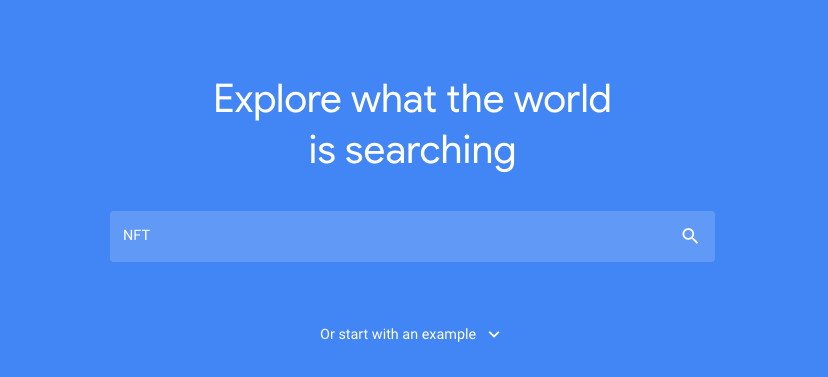
Non-Fungible Tokens (NFTs) are all the rage right now. So it wasn’t surprising to find that the interest in this topic has astronomically risen in the last few months.
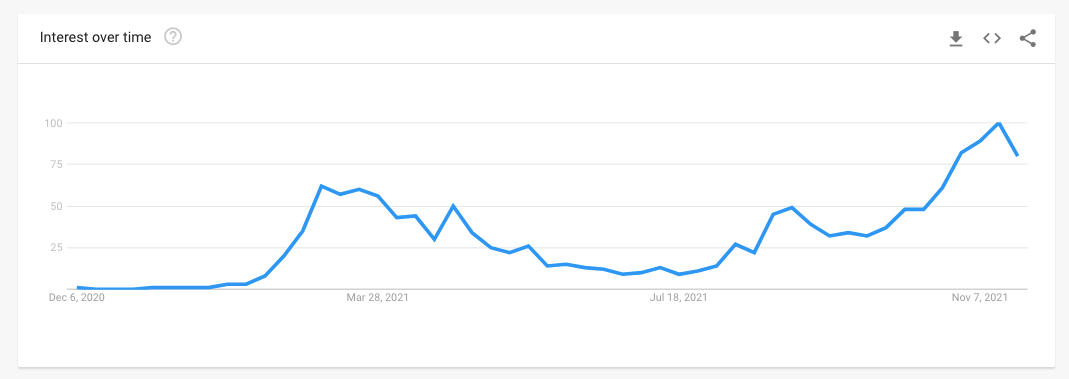
Since it’s a popular keyword, you can scroll down and find a lot of “breakout” keywords in the “Related queries” section.
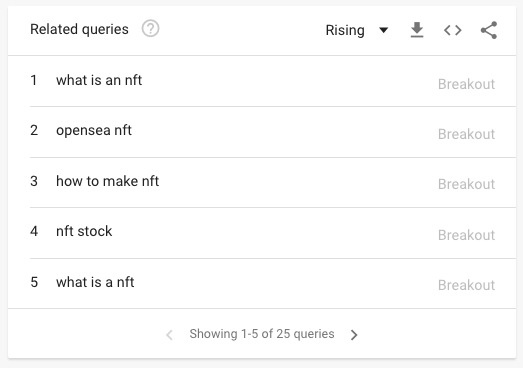
All of this makes “NFT” and NFT-related queries excellent keywords to target right now.
So that covers keywords that are rising in popularity and the ones you should probably include in your content strategy.
But what about those keywords that are losing popularity? Google Trends has got you covered here as well.
Take, for example, the declining popularity of the once popular mobile game Pokemon Go:
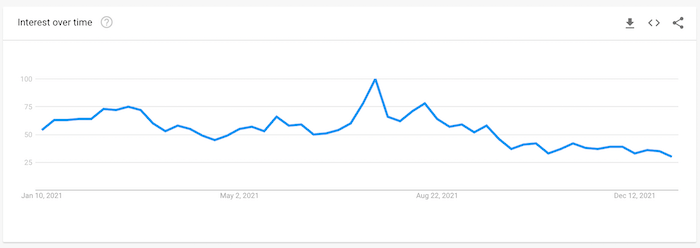
So if you have a mobile gaming blog, you’d probably want to create content around a game that’s trending in the current year.
What really bolsters the “Trending Searches” feature is the list of related keywords you can generate from your initial search query.
Here’s a quick overview of how to generate related keywords in Google Trends:
First, plug in your keyword phrase in the search bar:

In the results page, scroll all the way down till you find the “Related queries” section:
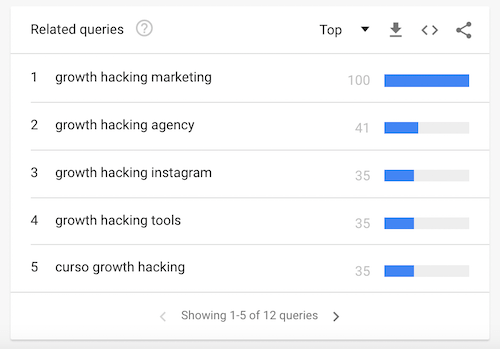
This is the list of keyword phrases closely related to your typed in search query.
At first glance, this may seem like the “Related searches” section that you find at the end of Google SERPs.
But these keywords are different.
These are the trending keywords within the topic you just searched for.
Furthermore, Google also shows you the exact percentage search volume for each of these keywords.
It’s a really cool feature to identify low-hanging keyword opportunities and new content ideas in your niche.
6. Find Keyword Ideas for YouTube
If you have a YouTube channel, then you can use Google Trends to unlock a treasure trove of content ideas for your future videos.
You can use Google Trends to find top or rising video topics in your niche.
To use Google Trends for video research, enter the topic you’d like to create a video on and then use the dropdown menu to switch from “Web Search” to YouTube Search.”
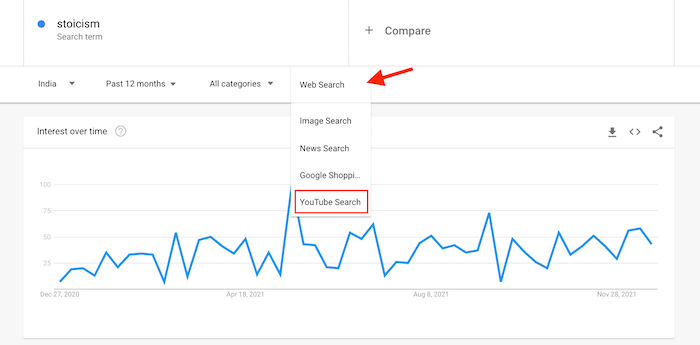
You’ll then see the interest generated for your topic on YouTube.
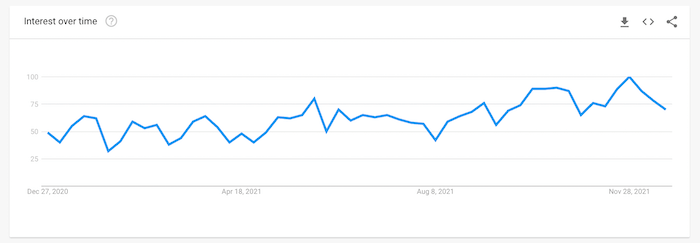
You can also scroll down to the “Related topics” and “Related queries” sections to find more keyword ideas.
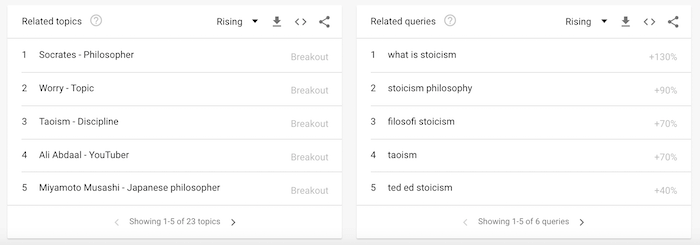
Here you’ll find keywords that are closely related to your target keyword and you’ll have a broad list of trending topics to choose from for your next YouTube video.
Related: 15 Best Marketing YouTube Channels (That Are Worth Subscribing To)
7. Compare Search Trends
If you want to understand the scale of a trend, you need to use relative comparisons to find out how popular a search term is.
For instance, Google recommends that we use weather as a point of reference for all searches.
Why?
Because weather is one of the most consistently searched for topics worldwide.
To compare search terms, first enter a term in the search bar that you’d like to use as a point of reference, like “weather.”
Next, hit “+ Compare” and add the topic whose popularity you want to gauge, like “bitcoin.”
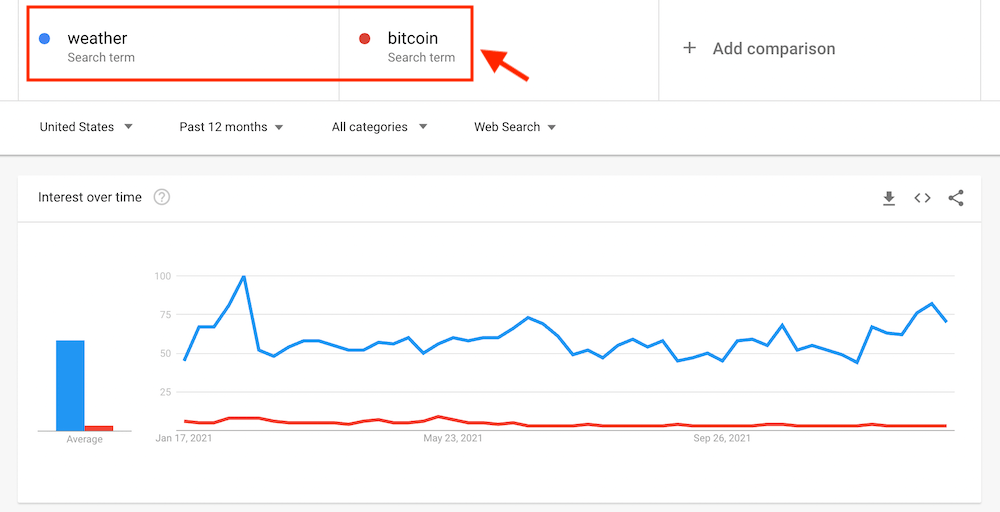
You can add up to 5 groups of search terms at a time, like this:
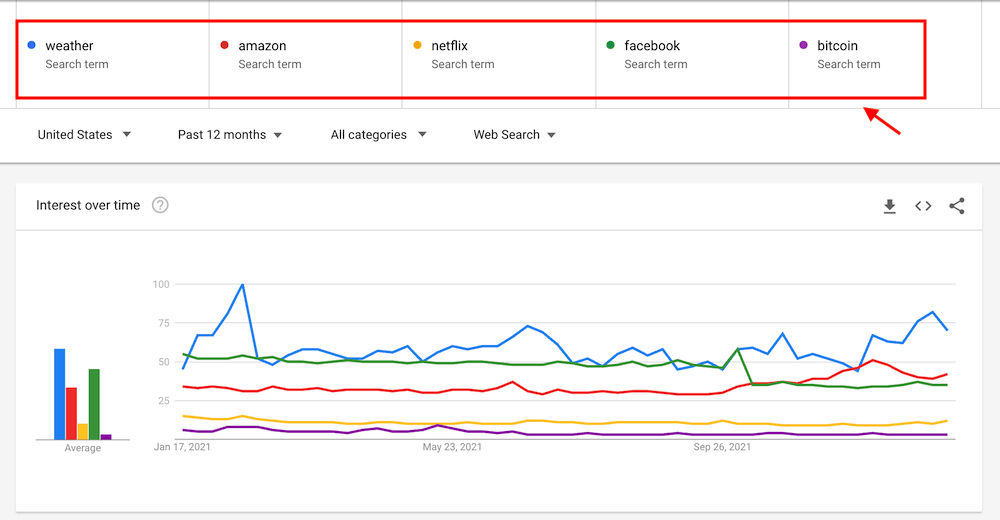
This really puts things into perspective and you can gauge the relative popularity of the topic you’d like to produce content on.
Similarly, Google Trends also lets you compare the interest for a particular search query in different locations.
To use this feature, enter the same search query twice and then click the three dots next to one of the search boxes to open a drop-down menu.
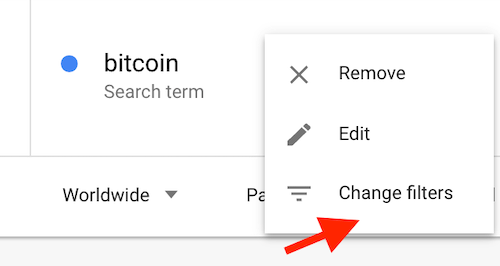
Click on “Change filters” here and then apply the relevant filters.
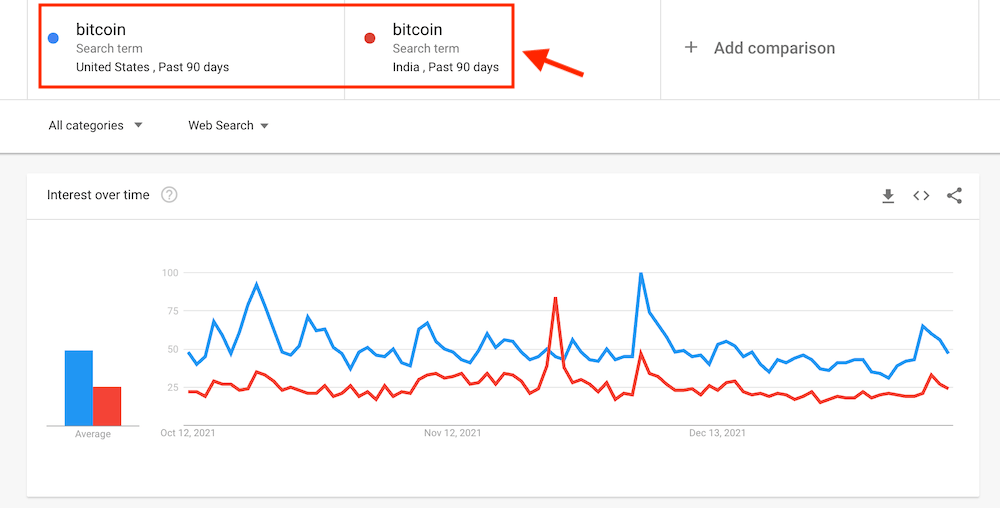
As you can see from the screenshot above, the interest for “Bitcoin” is relatively higher in the US than in India. Which means you can expect greater organic traffic from the US for any content you create around “Bitcoin” as long as it’s useful and relevant to the audience and adheres to the Google E-A-T guidelines.
8. Analyze Your Competitors
As baffling as it may sound, there’s a sneaky trick to use Google Trends as a valuable competitor analysis tool.
How?
Simply search for your brand name in Google Trends and scroll all the way down to the “Related queries” section.
Let’s take ConvertKit, a popular email marketing service, as an example.
Here are the related queries for the search term “ConvertKit”:
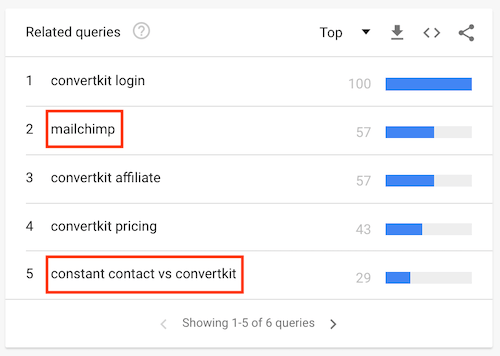
As you can see, people who search for ConvertKit also search for two of their main competitors — Mailchimp and Constant Contact.
This indicates that people who are searching for ConvertKit are most likely researching on the best email marketing services or they are existing customers of ConvertKit’s competitors who are planning to make a switch.
In both cases, they are potential ConvertKit customers.
Which means if ConvertKit were to publish a “Mailchimp vs ConvertKit” comparison post or page, showing how ConvertKit is superior to Mailchimp in terms of features and other factors, they’d be able to drive a few users away from Mailchimp or convince a whole new set of users on why they should opt for ConvertKit over Mailchimp.
Looks like the content team behind ConvertKit has already done their homework since this long-form landing page on their site ranks at #1 for the keywords “Mailchimp vs ConvertKit”:
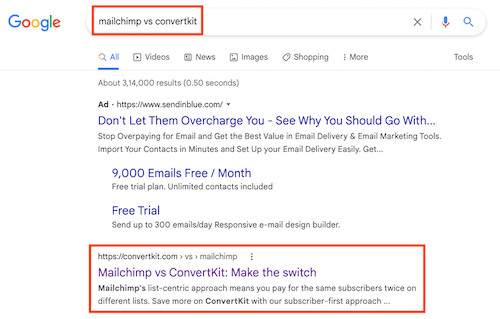
Related: 7 Best Competitor Research Tools to Spy on Your Competition
9. Plan Your Content Calendar
Google Trends is an excellent tool if you want to plan your content calendar in advance.
Since search volumes are hugely influenced by seasonality, you can leverage Google Trends to figure out the best time to publish or promote a specific piece of content.
For example, check out the Google Trends data for “Black Friday” in the US over the past 5 years:
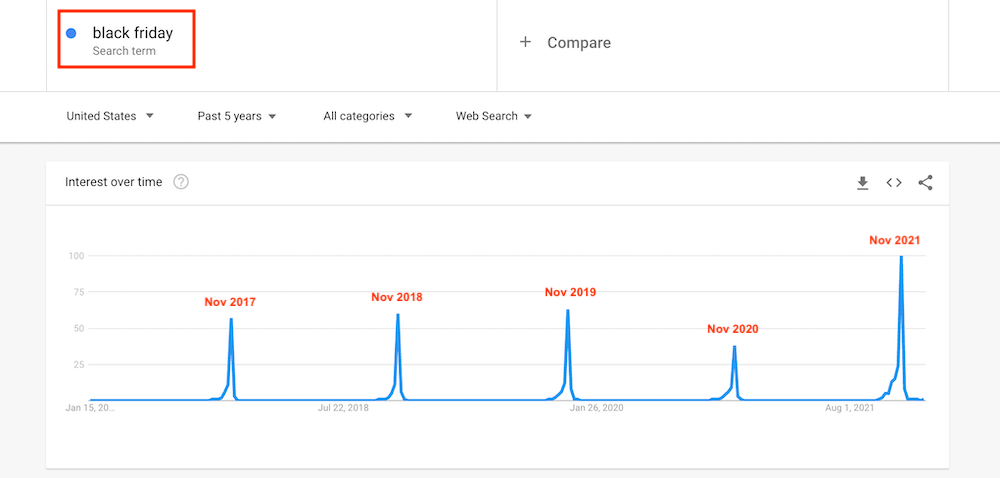
Notice the peak for this search phrase occurs at roughly the same time every year.
This is because Black Friday takes place in November every year.
So if you run an eCommerce store or have a list of Black Friday deals on your site, this would be the ideal time to update your Black Friday landing pages to boost your sales.
Now, this is an obvious example. Of course, Black Friday is held in November every year. You don’t need to fire up Google Trends just to figure this out. If you’re run an eCommerce store, you probably already have this covered.
Let’s take a look at a less obvious example.
Here’s the Google Trends data for “chicken wings” in the US for the past 5 years:
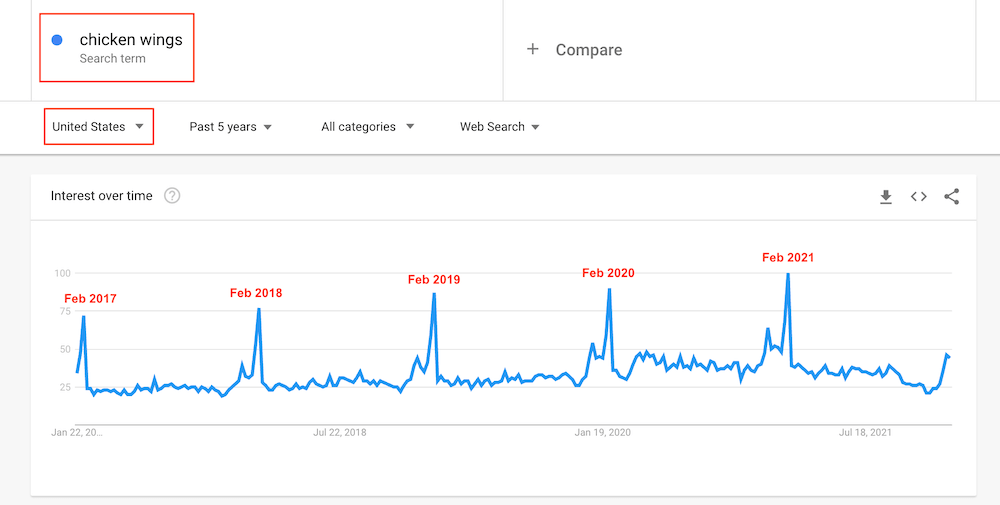
Once again, you’ll notice the peak for this phrase once at the same time every year: February.
Any guesses why? Here’s a clue: It has something to do with America’s most-watched sporting event — the Super Bowl. The Super Bowl is held on the first Sunday of February every year.
Fun fact: Super Bowl LVI will be the first Super Bowl to be played on the second Sunday in February.
Now what do chicken wings have to do with Super Bowl?
It just so happens that chicken wings is one of the most popular foods that is consumed during Super Bowl.
Case in point: Americans ate a record 1.42 billion chicken wings during Super Bowl 2021.
Which is why the search interest for “chicken wings” peaks in February.
So if you run a food blog, you should probably publish or update your existing chicken wings recipe post or have a list of chicken wings recipes in the weeks leading up to the Super Bowl.
Like GMA has done here for the upcoming Super Bowl LVI:

So this is how you can use Google Trends to plan your content calendar well in advance.
Final Thoughts on Using Google Trends for SEO
Google Trends is not the de facto tool for keyword research for content creators and SEO professionals. But as you can see, you can use Google Trends to unpack loads of keyword ideas and improve your site’s SEO.
To summarize, here’s a quick recap of the 9 actionable techniques to use Google Trends for keyword research and SEO:
- Find new keyword ideas
- Discover “breakout” keywords
- Optimize your local SEO
- Get accurate search volume trends
- Uncover related keywords
- Find keyword ideas for YouTube
- Compare search trends
- Analyze your competitors
- Plan your content calendar
Now I’d like to hear from you. What do you think of Google Trends? Is it a part of your SEO and marketing toolkit? If the answer is yes, then how do you use it to optimize your keyword research efforts? Please let me know in the comments section below.
If you found this article useful, please share it on Twitter using the link below:
Related Articles






